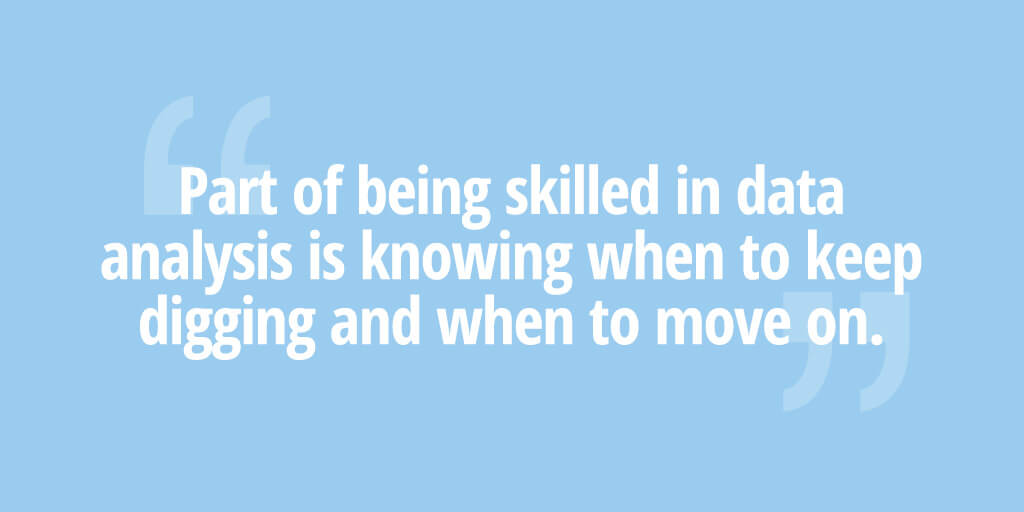Big Data Paralyzing Your Business? (Part 2)
…

In some cases, data distrust occurs not because of actual inaccuracies but perceived ones. When new data is introduced, it may be inconsistent with pre-existing data and beliefs, which may lead to cognitive dissonance. When people experience inconsistency (dissonance) such as conflicting information, they are motivated to dismiss the new evidence as erroneous rather than questioning their original data or opinion. Rather than automatically assuming you have a data quality issue, you may have a change management issue instead.
How to overcome Data Distrust:
- Evaluate whether data issues are isolated, widespread or imagine
- Review the severity and frequency of the data discrepancies
- Work with IT team to keep the data within an acceptable margin of error
- Hold teams accountable for maintaining data quality and introduce processes to reduce errors
- Win back confidence in the data by demonstrating its precision and usefulness
2. Data Daze

While data daze may be less familiar than analysis paralysis or data distrust, you’re likely to have already experienced it personally or seen other people hampered by it. As data becomes more and more pervasive, data daze occurs when individuals become intimidated or overwhelmed by the sheer volume of data placed in front of them. Essentially, data daze is a form of information overload when someone is attempting to consume too many metrics/dimensions, charts, reports and so on at the same time. When an audience’s eyes glaze over during a data-intensive presentation or as they review a complex dashboard, you’re often seeing the effects of data daze.
The human brain can only consume so much information before becoming overloaded. In 1956, psychologist George A. Miller found that most people can only handle 7 chunks of information (+/- 2) at a time. In 2004, psychologist Barry Schwartz introduced the Paradox of Choice where having more options to choose from actually increases our anxiety and interferes with our ability to make decisions as consumers. Similarly, when people are inundated with too much data, they become stuck and unsure of how to move forward—even before any analysis is performed.
If less is more, we’re certainly our own worst enemies when it comes to data sharing and consumption. For example, rather than focusing on a limited set of Key Performance Indicators (KPIs), many organizations amass large collections of purported KPIs. Unfortunately, when every metric is flagged as being important or essential, it waters down the purpose and benefits of having KPIs. When this happens, noise and confusion are introduced rather than creating a strong signal for improving business performance.
In an attempt to be helpful, analysts often pack reports, infographics and dashboards with lots of juicy information and visualizations. However, they don’t always have a clear sense of what the people consuming the data really need or want. Throwing data at a wall to see what sticks is a problematic approach that can induce data daze. In these situations, analysts shouldn’t be guessing what business stakeholders need, and end users should clearly articulate what they’re trying to understand and achieve (which can and will evolve).
As follow-on questions based on the data arise, additional information is often appended to the existing reports and dashboards. However, simply providing more information becomes an easy but sloppy substitute for curating the existing data, removing what’s not relevant and offering up the right information.
A lack of knowledge or training can also contribute to data daze in a couple of ways. When individuals don’t know how to visualize data effectively or tell a compelling data story, the information they share can leave people more perplexed than empowered. As well, when people consuming data don’t understand the metric definitions or how to interpret the numbers, you again run into another roadblock to data adoption. Both of these contributing factors can be addressed through proper training and education—both for people producing and consuming data.
How to overcome Data Daze
- Re-visit your KPIs and supporting metrics to ensure they align with your corporate strategy
- Consolidate and curate your KPIs and supporting metrics to increase their relevance and potency
- Organize sets of supporting metrics under KPIs hierarchically or thematically
- Chunk data into more digestible layers or groupings that can be drilled into by business users
- Strive to simplify and improve data visualizations and report/dashboard layouts
- Train employees on how to properly visualize data, craft data stories and interpret data
3. Analysis Paralysis

When people think of data impeding progress, they often think of paralysis by analysis. Typically, analysis paralysis occurs when someone over-analyzes or overthinks their data and fails to arrive at a key insight, decision, or outcome. It often plagues analysts, data scientists, and even analytical leaders who keep drilling deeper into the numbers but get lost in the process and fail to extract anything valuable. Sometimes, no matter how much we poke and probe the numbers, they may not reveal anything insightful or actionable.
For example, an analyst was analyzing an email marketing program and was struggling to find something substantial in the data. While he wanted to provide a slam-dunk insight, his main stakeholder—a data-savvy email marketer—had done a good job of optimizing the email program over the past several years. Rather than continuing his analysis, the analyst decided to review his intermediate findings with the stakeholder to see if it would trigger other perspectives or questions. In the end, the partial findings ended up forming 90% of the final deliverable and were sufficient to answer most of her business questions even though it didn’t result in any earth-shattering insights or recommendations. Part of being skilled in data analysis is knowing when to keep digging and when to move on. Recently, I had the opportunity to interview executives across various departments at a few different organizations. On a couple of occasions, an executive mentioned how his or her team was struggling with “analysis paralysis.” While their teams may have been immobilized by data, the paralysis they were experiencing was clearly occurring BEFORE the teams even attempted to examine or explore their data in depth. It’s more likely that they were suffering from the effects of data daze than analysis paralysis.
While the phrase “analysis paralysis” is fairly well-known, the malady isn’t as common outside of analytical roles. Most companies haven’t yet reached a data maturity level where a significant number of business users are routinely performing analysis on their own. However, as companies embrace self-service analytics and data skills evolve, this form of data paralysis will occur more frequently as the opportunity to explore data becomes more decentralized and democratized.
How to overcome Analysis Paralysis:
- Set a time limit and carefully monitor your progress
- Step away from the problem and try again with a fresh perspective
- Share your analysis approach with someone else to gain a different viewpoint
- Revisit the original business question(s) to refocus your effort
- Go back to basics and try a simpler analysis approach
Becoming a more data-driven company is a journey—not a destination. Ultimately, companies need all of their leaders and employees to join them in that journey, but unfortunately some people will get lost along the way. Some individuals will lose faith in the data. Others will be overwhelmed by the volume of information being shared. Yet others may dive into the data looking for insights and never re-surface. Mitigating and overcoming these paralyzing traps is important to driving action and value with your data. The more people who can participate in this data journey and remain on the path, the better it will be for your company’s long-term success with data.
**This article was originally published on Forbes.com on September 16, 2016
What's Your Reaction?


























:quality(85):upscale()/2024/09/09/785/n/1922283/901e710666df358b373de2.40207443_.jpg?#)
:quality(85):upscale()/2024/07/23/904/n/1922283/dc92642c66a0159ee98db4.72095370_.jpg?#)
:quality(85):upscale()/2024/07/10/842/n/1922283/8fb902af668edd399936b2.17277875_.jpg?#)
:quality(85):upscale()/2024/06/07/909/n/1922283/82a389f8666372643f2065.06111128_.jpg?#)
:quality(85):upscale()/2024/06/07/726/n/1922283/10bee64e666334778cf548.63095318_.jpg?#)
:quality(85):upscale()/2025/01/08/844/n/1922398/cde2aeac677eceef03f2d1.00424146_.jpg)
:quality(85):upscale()/2024/11/27/891/n/1922398/123acea767477facdac4d4.08554212_.jpg)
:quality(85):upscale()/2024/12/02/919/n/1922398/2b4b75f6674e20edcc99c3.42112799_.jpg)
:quality(85):upscale()/2024/10/29/690/n/1922398/e9bec6b46721006258d949.01358236_.jpg)
:quality(85):upscale()/2024/10/09/794/n/1922283/3f35cdf56706c5a92ddff9.14514426_.jpg)









:quality(85):upscale()/2024/02/21/214/n/1922283/8118faa965d6c8fb81c667.06493919_.jpg?#)

